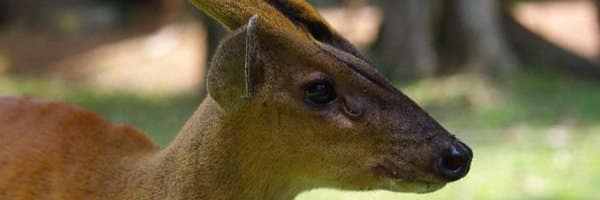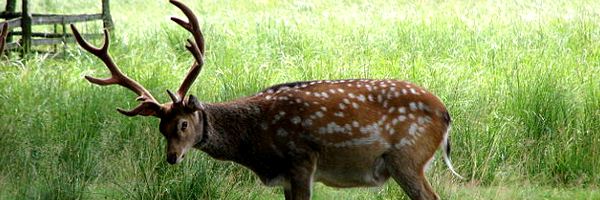Photo taken by ZeWrestler
Water Deer – Hydropotes inermis
The Water Deer has tusks rather than antlers which is very interesting. In spite of what is though, they are genetically proven to be a class of deer. They feature a neck that is very long and elegant. The rear legs are longer than the front ones so it has an appearance of carrying itself high in the shoulder region.
They are a golden brown color but also can have some black hairs spread out. They aren’t very noticeable though unless you see the Water Deer up close. They can have some patches of white or cream as well. They have a tail that is so short it is almost invisible unless you look for it.
The full grown males weigh about 32 pounds with the females about 20 pounds. They are about three feet tall when they are fully grown, so they fall into the category of a small species.
Water Deer Distribution
China and Korea are the main areas where the Water Deer live in their natural habitat. By their name you have already figured out that they live close to bodies of water. The Yancheng Coastal Wetlands area is what they boarder. This follows along the Yangtze River area. They hide well along the tall reeds and grasses. Some of them do move into the low mountain areas too and seem to do very well there. Others remain in the wet grassland areas.
Water Deer Behavior
They are excellent swimmers and do to the fact that they live so close to water they are often found moving that way instead of on land. They can swim for many miles at a time without using up very much energy. They are solitary animals with the exception of mating season.
Water Deer Feeding
The diet of the Water Deer consists of grass, twigs, berries, and anything that constitutes those types of vegetation in those areas. They seem very content to feed slowly and they get lots of water from what they consume. Even so, they do still need to drink plenty of clean water.
Water Deer Reproduction
The males are very territorial and that only increases when the rut starts. They leave very strong odors through their urine and feces. When two males are in the same area for mating they will stand off with each other. They will make eye contact and move in circles. Since they don’t have antlers they can’t battle like other species of deer do.
However, they do use their tusks to try to stab at each other. Usually one of the males will run off before the situation is raised to that level. When you see a Water Deer with scars on its face, it is usually the result of engaging in those types of battles.
They males give off barking sounds when they are looking for females to mate with. By that time the females are already gathered in small groups waiting around. The male will mate with all of the females in that group. After mating it can take up to 6 months for the offspring to arrive.
The females will give birth to either 2 or 3 young but some litters do have as many as 7. The young are taken to a secluded area where they are able to remain well hidden for about one month. The young seem to delight in each other’s company but it can be a demanding task for the mother to care for many at once. They will venture out on their own when they are about 6 months old.
Water Deer Conservation
A watchful eye is out there on the Water Deer because they are seen as a type of species in danger. Some believe that without conservation efforts they could easily be on the Endangered Species list in a decade or less. Part of the drop in numbers comes from their natural habitat being taken away from them. Pollution in the water is a serious problem too as they need lots of fresh drinking water.







